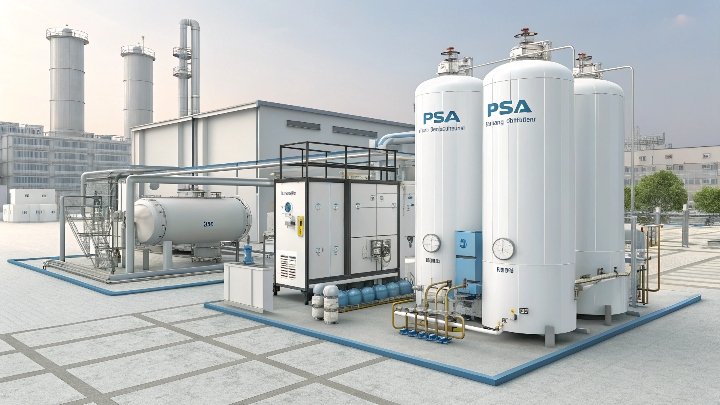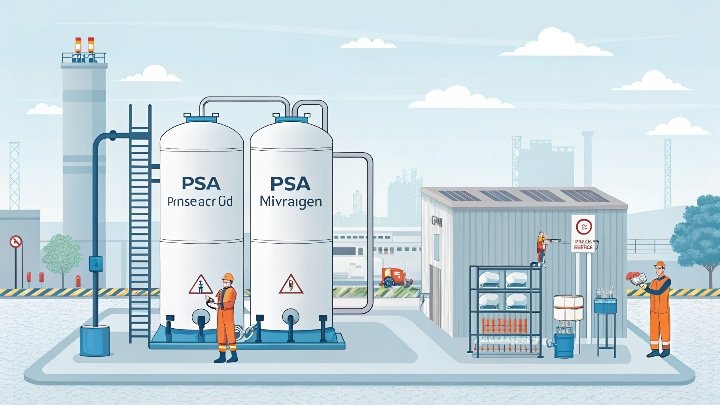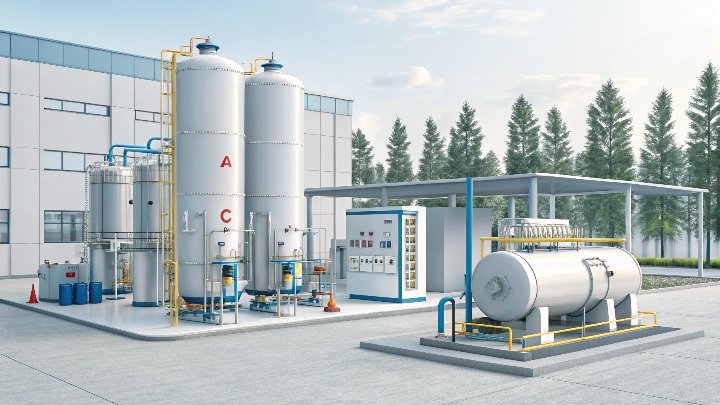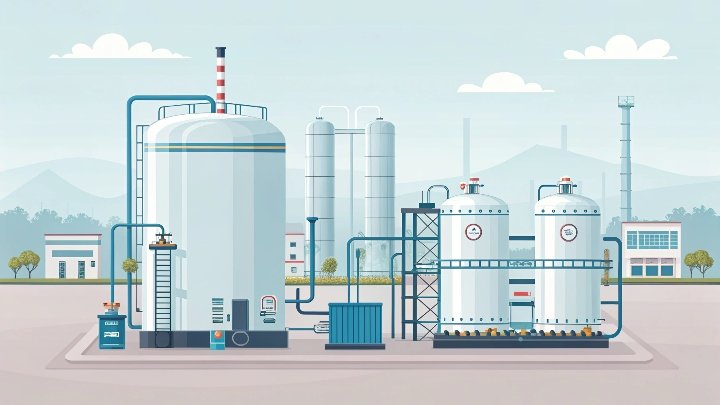I see many industries that need a stable nitrogen supply, yet they often worry about costs and reliability.
PSA nitrogen plants work by separating nitrogen from air using carbon molecular sieve. This process creates a steady supply of high-purity nitrogen on-site, which helps lower operating costs and increase production efficiency.
I want to share more details about how this technology works, so you can see why it is valuable in fields like food, chemicals, and electronics.
How does a PSA plant work?
I hear people ask this question often, because the concept sounds complicated at first.
A PSA plant uses pressurized air and adsorbent materials to capture oxygen, leaving nitrogen behind at high purity. This lets me produce nitrogen where I need it.
How a PSA Plant Works
I want to explain this step by step. The PSA (Pressure Swing Adsorption) plant takes in compressed air from the atmosphere. This air contains around 78% nitrogen, 21% oxygen, and traces of other gases. The air enters one of two adsorber vessels filled with carbon molecular sieve (CMS). The CMS selectively adsorbs oxygen because oxygen molecules fit more easily into the tiny pores of the carbon sieve. Nitrogen molecules do not get trapped as much, so they can pass through.
When I say “pressure swing,” I mean that the adsorber vessel operates at a higher pressure to adsorb oxygen, then swings to a lower pressure to release that oxygen so the vessel can be reused. The system alternates between two towers. While one tower is adsorbing oxygen, the other tower is regenerating. This way, the PSA plant can run continuously, producing a steady flow of nitrogen at purities that can exceed 99%.
I have learned that carbon molecular sieve is essential for effective nitrogen separation. Its pore size is tuned to adsorb oxygen more strongly than nitrogen. I also know that the efficiency of the process depends on the design of the vessels, the cycle time, and the quality of the CMS. With the right design, a PSA plant can reach desired nitrogen purities without needing complex cryogenic procedures.
In practical terms, a PSA plant requires a compressor, some control valves, two or more adsorber vessels, and a reservoir for the product gas. The vessels cycle in an ongoing pattern, so there is a near-constant flow of nitrogen. I like how the system can be scaled up or down depending on a facility’s production needs.
From my experience, PSA plants are common in industries like food packaging, electronics manufacturing, and chemical processing. In food packaging, high-purity nitrogen is used to displace oxygen in sealed packages, which prolongs shelf life. In electronics manufacturing, dry nitrogen helps minimize oxidation in sensitive processes. In chemical plants, nitrogen is used as a blanketing gas to reduce fire and explosion hazards.
My takeaway is that a PSA system works by cleverly exploiting the different adsorption properties of nitrogen and oxygen on carbon molecular sieve. The result is a reliable, on-site source of nitrogen gas with fewer recurring costs compared to delivered cylinders. By avoiding deliveries and storage hazards, I feel more in control of production and safety. This technology stands out as a smart option for businesses that value cost-effective and high-quality nitrogen supplies.
What is the working principle of PSA?
I have seen many approaches to generating nitrogen, but PSA stands out because it is easy to run and maintain.
PSA relies on different affinity levels between oxygen and the adsorbent, allowing me to obtain high-purity nitrogen without cryogenic methods.
Working Principle of PSA
I want to lay out the underlying principle that makes PSA feasible. Pressure Swing Adsorption is based on selective adsorption, meaning one gas gets trapped inside the adsorbent pores more than the other. In this case, the adsorbent is often carbon molecular sieve for nitrogen generation. Oxygen binds to the CMS at higher pressures, while nitrogen remains unadsorbed and becomes the product gas. When the system lowers the pressure, the trapped oxygen is released, allowing the adsorbent to regenerate.
This principle is important because it circumvents the need for expensive cryogenic distillation. In cryogenic distillation, air would be cooled to very low temperatures until it liquefies, then separated by boiling points. That process is more complex and consumes more energy. PSA offers a simpler alternative by using moderate pressures and the natural tendencies of adsorbent materials.
I have noticed that the cycle time in a PSA system is brief. The switch between high pressure and low pressure must be fast enough to keep the nitrogen flowing. The actual pressure levels can vary, but they are typically in the range of 6 to 10 bar for adsorption. The release or regeneration step occurs at near-atmospheric pressure.
I often compare PSA to a sponge that soaks up oxygen under certain conditions, then squeezes it out under others. The repeating cycle of adsorption and desorption makes the process continuous. I believe the key to good performance is selecting an adsorbent with a strong preference for oxygen. Carbon molecular sieve is formulated with pore sizes that are just the right fit for oxygen molecules.
People sometimes ask me if PSA can generate other gases. The principle can be adapted. For instance, 13X molecular sieve is used in Temperature Swing Adsorption (TSA) to produce nitrogen or separate other components. TSA is a similar concept, but it uses heat and time to remove adsorbed species instead of rapid pressure changes. However, PSA is typically faster and less energy-intensive for nitrogen production.
In summary, the working principle of PSA revolves around selective adsorption. When pressurized air flows into the vessel, oxygen molecules stick to the adsorbent. Nitrogen molecules pass through, leading to a continuous stream of nitrogen. Then, the adsorbent regenerates by releasing oxygen at low pressure. This cycle repeats, giving me an on-demand nitrogen source without big energy costs.
What is the working principle of nitrogen gas plant?
I have encountered many nitrogen generation methods, but PSA plants have proven to be more convenient and cost-effective.
The principle behind a nitrogen gas plant is to remove oxygen and other gases from the air until almost pure nitrogen remains.
Working Principle of a Nitrogen Gas Plant
I want to outline the different ways a nitrogen gas plant can operate, focusing on PSA and TSA. In a PSA-based nitrogen plant, the adsorbent is usually carbon molecular sieve. I know that carbon molecular sieve has micro-pores that can trap oxygen molecules more readily than nitrogen molecules. This leads to a higher concentration of nitrogen at the outlet. Meanwhile, TSA (Temperature Swing Adsorption) often uses 13X molecular sieve and relies on heat to remove the adsorbed oxygen. TSA resembles air separation systems, except it avoids the cryogenic step. However, TSA can be slower and might need more energy because of the heating process.
When I think about designing a nitrogen gas plant, I consider factors like required purity, desired flow rate, and maintenance costs. PSA is straightforward and can achieve nitrogen purities of over 99%. If I need even higher purity, I can add extra purification stages, such as deoxygenation with a catalyst or additional adsorbents. But for most industrial applications, 99% purity is enough to meet quality standards.
I have found that on-site nitrogen generation reduces the hassles of storing and transporting high-pressure nitrogen cylinders. With an in-house plant, I can produce the gas I need, when I need it. This lowers my operational risk because I am not waiting on deliveries or dealing with supply chain disruptions. It also cuts costs in the long run. A nitrogen gas plant is not only about convenience, but also about control. I can monitor purity levels in real time. I can optimize my process conditions, such as cycle times and pressure settings, to match my production demands.
Another aspect I like is the flexibility of scale. A nitrogen gas plant can be sized to support small labs or large manufacturing lines. By adjusting the number of adsorption towers, compressor capacity, and flow control, I can get the right fit for different facility sizes. This also helps me adapt if production expands.
In practical applications, nitrogen is used for preventing oxidation, purging lines, or blanketing storage tanks. In electronics, nitrogen protects sensitive components. In food processing, nitrogen extends product shelf life. In chemical plants, it reduces the risk of fire or explosion. All these applications demand a reliable nitrogen supply. That is why a well-designed nitrogen gas plant is valuable. It gives me control over purity, flow rate, and cost. PSA technology, with its carbon molecular sieve approach, keeps the process efficient and dependable.
By understanding how a nitrogen gas plant works, I can see the benefits of using PSA. It is simple, cost-effective, and suitable for many industries. In my view, that is why PSA plants continue to gain popularity. They produce high-purity nitrogen without relying on complex cryogenic systems or expensive external deliveries.
Conclusion
A PSA nitrogen plant offers a reliable path to high-purity nitrogen. It is efficient, scalable, and easy to operate with minimal costs.






